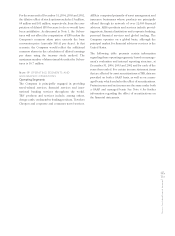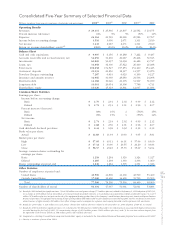American Express 2004 Annual Report Download - page 116
Download and view the complete annual report
Please find page 116 of the 2004 American Express annual report below. You can navigate through the pages in the report by either clicking on the pages listed below, or by using the keyword search tool below to find specific information within the annual report.
The weighted average assumptions used to determine
net periodic benefit cost were:
2004 2003 2002
Discount rates 5.7% 6.2% 7.0%
Rates of increase in
compensation levels 4.0% 4.0% 4.2%
Expected long-term rates
of return on assets 7.9% 8.1% 9.3%
For 2004, the Company assumed on a weighted aver-
age basis a long-term rate of return on assets of 7.9%.
In developing the 7.9% expected long-term rate
assumption, management evaluated input from an
external consulting firm, including their projection of
asset class return expectations and long-term inflation
assumptions. The Company also considered the his-
torical returns on the plan assets.
The asset allocation for the Company’s pension plans at
September 30, 2004 and 2003, and the target allocation
for 2005, by asset category, are below. Actual alloca-
tions will generally be within 5 percent of these targets.
Target
Allocation
Percentage of
Plan assets at
2005 2004 2003
Equity securities 68% 68% 66%
Debt securities 26% 27% 26%
Other 6% 5% 8%
Total 100% 100% 100%
The Company invests in an aggregate diversified
portfolio to ensure that adverse or unexpected results
from a security class will not have a detrimental impact
on the entire portfolio. The portfolio is diversified by
asset type, performance and risk characteristics and
number of investments. Asset classes and ranges con-
sidered appropriate for investment of the plans assets
are determined by each plan’s investment committee.
The asset classes typically include domestic and for-
eign equities, emerging market equities, domestic and
foreign investment grade and high-yield bonds and
domestic real estate.
The Company’s retirement plans expect to make ben-
efit payments to retirees as follows (millions): 2005,
$132; 2006, $141; 2007, $150; 2008, $160; 2009, $171;
and 2010 – 2014, $1,013. In addition, the Company
expects to contribute $59 million to its pension plans
in 2005.
Defined Contribution Retirement Plans
The Company sponsors defined contribution retire-
ment plans, the principal plan being the Incentive Sav-
ings Plan, a 401(k) savings plan with a profit sharing
and stock bonus plan feature which covers most
employees in the United States. See Note 15 for further
discussion of this feature. The defined contribution
plan expense was $161 million, $145 million and $131
million in 2004, 2003 and 2002, respectively.
Other Postretirement Benefits
The Company sponsors defined postretirement benefit
plans that provide health care and life insurance to cer-
tain retired U.S. employees. Net periodic postretire-
ment benefit expenses were $38 million, $42 million
and $38 million in 2004, 2003 and 2002, respectively.
Effective January 1, 2004, the Company decided to no
longer provide a subsidy for these benefits for employ-
ees who were not at least age 40 with at least 5 years
of service as of that date. See Note 1 for a discussion
of the Company’s election to early adopt FSP FAS 106-2.
The recognized liabilities for the Company’s defined
postretirement benefit plans are as follows:
RECONCILIATION OF ACCRUED BENEFIT COST AND TOTAL
AMOUNT RECOGNIZED
(Millions) 2004 2003
Funded status of the plan $ (397) $ (428)
Unrecognized prior service cost (13) (22)
Unrecognized actuarial loss 162 206
Fourth quarter payments 810
Net amount recognized $ (240) $ (234)
Accumulated benefit obligation
at period end $ (397) $ (428)
Weighted average assumptions to determine benefit
obligations:
2004 2003
Discount rates 5.75% 6%
Health care cost increase rate:
Following year 10.5% 11%
Decreasing to the year 2016 5% 5%
AXP
AR.04
114
Notes to Consolidated Financial Statements
























